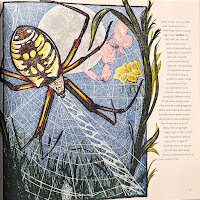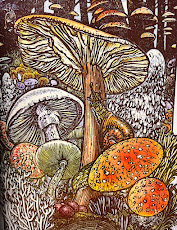This week, I was able to look at two collections of folktales as well as three collections of poetry for children.
Traditional Literature
1. Grimm, J., & Grimm, W. (1973, January 1). The Juniper Tree, and other tales from Grimm. Internet Archive. https://archive.org/details/junipertreeother0001unse/page/n7/mode/2up
Authority: Lore Segal was born in Vienna, Austria and sent to England on the Kindertransport, the initiative that saved almost 10,000 children Jewish and Non-Jewish alike. She started writing in a journal (in German) when she was 11 years old and went on to publish multiple books, one being a finalist for the Pulitzer Prize. She went to Bedford College for Women at the University of London and graduated with an honors degree in English. The authority that this woman has to translate folktales cannot be understated!
Style: The storytelling style is definitely preserved, though some lend themselves to being told aloud and others are simply too long to do so. Nevertheless, reading the tale with the inflection of an oral story is delightful though!
Purpose & Audience: The nice thing about this collection is that is contains the classic Grimm tales like "Hansel & Gretel", "Rapunzel", and "Snow White & The Seven Dwarves"; but it also contains tales that are not often (if they ever have been) translated and so many of these tales are new to me even though I have grown up on fairytales. "The Three Feathers" had me cheering for the third son, "The Story of One Who Set Out to Study Fear" though a mouthful, caught me off guard with its sweetness and silliness. Though a few might best be kept for older audiences, I think these tales can easily be adapted for all ages.
Scope & Organization: This collection includes 27 tales of varying popularity, length, and tone. They don't seem to be organized in a specific way, but the more well-known stories are peppered in between the lesser-known ones.
Illustrations: The illustrations are charming, and Maurice Sendak's style is iconic, but I don't know that there would be anything missing from the collection if they were not in it. There are 27 illustrations (one for each tale) and they are an added bonus, but nothing more.
2. Hamilton, V. (1985). The people could fly: American black folktales (L. Dillon & D. Dillon, Illus.). Alfred A. Knopf.

Purpose: Virginia Hamilton created this collection of Black Folktales to preserve these tales and share the culture that has been created since enslaved people stepped foot in this country and immediately began influencing storytelling with their imagination and optimism. What was done to enslaved people in the beginning of our nation's history was truly unacceptable, and only by remembering this time, as well as the perseverance of enslaved individuals who continued to create beauty out of oppression can we prevent it from happening again.
Authority: The amazing thing about Virginia Hamilton's authority in this matter is that if you didn't know anything about her, you wouldn't realize just how much authority she has on the subject until almost the end of the collection. In Section 4: "Carrying the Runaways and Other Slave Tales of Freedom", Readers learn of a man who rowed enslaved men, women, and children across the Ohio river to freedom. They were then sheltered by John Rankin who helped them start a new life in Ohio. This story is already moving but then you reach the author's note at the end and learn that one of the fugitives that was helped by John Rankin is Virginia Hamilton's grandfather Levi Perry. Levi told his story to his 10 children regularly, and his oldest daughter, Etta Belle Perry Hamilton, told it to her daughter in turn.
Style: The style of these tales has completely captured the narrative voice of these pieces. It feels like you are settling down with an older friend and they are telling you all the silly things that Bruh Rabbit has been getting up to. The text feels spoken, and the mood is conveyed beautifully on the page whether comical or stoic.
Audience: I believe these stories were chosen to be shared amongst readers of all ages, the stories read as cautionary tales, bedtime stories, scary stories of things unexplainable, and stories of hope. There is something in this collection for everyone.
Scope & Organization: This collection contains 24 tales in four different categories:
"He Lion, Bruh Bear, and Bruh Rabbit & Other Animal Tales"
"The Beautiful Girl of the Moon Tower and Other Tales of the Real, Extravagant, and Fanciful"
"John and The Devil's Daughter and Other Tales of the Supernatural"
"Carrying the Runaways and Other Slave Tales of Freedom"
The organization is helpful, it allows you to have expectations going into each section for what you are about to experience. It also helps, from a librarian or teacher standpoint to narrow down the areas of focus in case you don't have time or resources to study the entire collection.
Poetry

Purpose: The purpose of this collection is to honor and pay homage to the authors' favorite poets. Alexander, Colderly, and Wentworth take inspiration from their favorite poets and incorporate some of their signatures and quirks into their own poetry. This is clearly stated in the preface as well as reiterated in the Index in the back where they provide background information on each poet mentioned. It is incredibly successful as the poetry along with the background info prompted an interest in the poets in myself after reading it. I found myself wanting to know more about the poets that inspired these poems and what about them was incorporated into the poetry.
Audience: Though there is not a specific age range of audience specified, Kwame Alexander is a poet and author who has written many books for children and educators and this book was selected by the Junior Library Guild which focuses on juvenile literature. Truly the poetry can be enjoyed at any age, however, and the bright, colorful, illustrations bring a sense of whimsy and depth at the same time.

Scope and Language: The language varies immensely from poem to poem which makes the collection exciting and spurs the reader onward as you don't know what is coming next. The poems utilize rhyme, alliteration, and other poetry mechanics in equal measure, and no two feel alike. The poems alternate between Alexander's, Colderly's and Wentworth's, but since they are each inspired by a different poet, it does not feel repetitive as each page brings something new.
Organization: The collection is grouped into three parts, "Part 1: Got Style?", "Part II: In Your Shoes", and "Part III: Thank You". Each section has a small introduction that explains a bit about why it's called such. Part I explores the style of each poet whether that includes their penchant for ellipses or interestingly placed upper and lowercase letters. Part II talks about the feelings that different poets can illicit, and Part III speaks to how they can affect us deeply and personally.

Illustrations: The illustrations by Holmes have a distinctly African feel with bright colors and stark shapes. They are a celebration, like poetry often is, and each illustration works with the poetry to create a distinctive mood on each page.
2. Bowles, D. (2018). They call me güero: A border kid’s poems. Cinco Puntos Press.

Purpose: This collection's purpose isn't quite as easy to wrap up with a bow. What is the purpose of any poetry? Catharsis? Release? To me, it seems the "purpose" of this collection is to share an experience, specifically the experience of a kid growing up on the Mexican/American border. Bowles poems travel through a little over a year in the life of "Güero", a seventh grader trying to navigate having pale skin and red hair in the midst of his fellow Mexican American peers.
Audience: Though isn't any content in this collection to bar it from younger audiences, I would recommend it for middle schoolers and older simply because I think they will get the most out of it. Novels in verse are a great way to introduce middle and high schoolers to a different way of viewing/experiencing poetry and I believe this could be an excellent tool for that purpose, as well as a great way to foster empathy and raise awareness for experiences that many American's might not often read about.
Scope and Language: This is a novel in verse so instead of feeling like a collection of poems that each tell a story, it can more accurately be described as one story told through many poems. The rhyme and meter changes throughout to fit the mood of each scene/vignette. Bowles utilizes free verse, end rhyme, sonnets, haikus, and more over the course of the story all the while making the reader feel right at home; the changes smooth and not jarring in the slightest. You can also believe that a seventh grader is writing this. It doesn't feel juvenile or too mature, it feels like a boy who is growing up using poetry to figure things out.
Organization: The organization of the poems are in chronological order with a few flashbacks placed throughout. The novel covers approximately a year and a half of Güero's life, and you can tell that time is moving by different poems like "Christmas Concrete" and "Valentine Texts". Along with his experience of Seventh Grade you also get insights into his childhood with poems like "Learning to Read" and "Losing Puchi".
3. Sidman, J. (2010). Dark Emperor & Other Poems of the Night (R. Allen, Illus.). Houghton Mifflin Books for Children.

Purpose: Though it is not explicitly stated, it seems the purpose of this collection is to not only explore the lives of nocturnal creatures through poetry, but also to teach readers about them. Each poem is about a different flora or fauna that comes alive in the nighttime. On the opposite page, along with a stunning relief print illustration, there is a paragraph of facts and traits about whatever subject the poem has just discussed. Whether it be an owl, a snail, or a mushroom, each page teaches the reader something new about these beautiful nocturnal creatures.


Audience: I highly recommend this book for young children. Though any age can enjoy the factoids and illustrations and poetry, this picture book is an excellent way to introduce these concepts to young (future) readers. The poems are not long or complicated and have the type of pleasing cadence that is perfect for reading aloud to a child at bedtime. The focus on nighttime flora and fauna also creates a sleepy atmosphere while giving plenty to satisfy the most inquisitive toddler (and if it doesn't, there is always Google to help you discover more facts about the Primrose Moth).

Scope and Language: Like I said previously, the language in these poems is not esoteric. Sidman uses everyday language that English-speakers of most levels should be able to understand, and for some of the trickier words, includes a glossary in the back. Though this collection only holds 12 poems, readers are given plenty to explore with the inclusion of illustrations and facts. I spent quite a while perusing this collection and trying to soak up every detail (especially of Rick Allen's intricate relief prints) kept me enthralled.
Organization: Obviously the entire collection is night themed, but besides that, there does not appear to be any sort of order to these poems, which is pleasant as it feels like you are almost taking a midnight stroll and you just "come upon" different animals or catch a glimpse of an oak tree soaking up the night.







Wonderful job in evaluating each text according to the assignment topics. Look to start weaving these into concise, smoothly flowing reviews rather than answers to the questions.
ReplyDelete